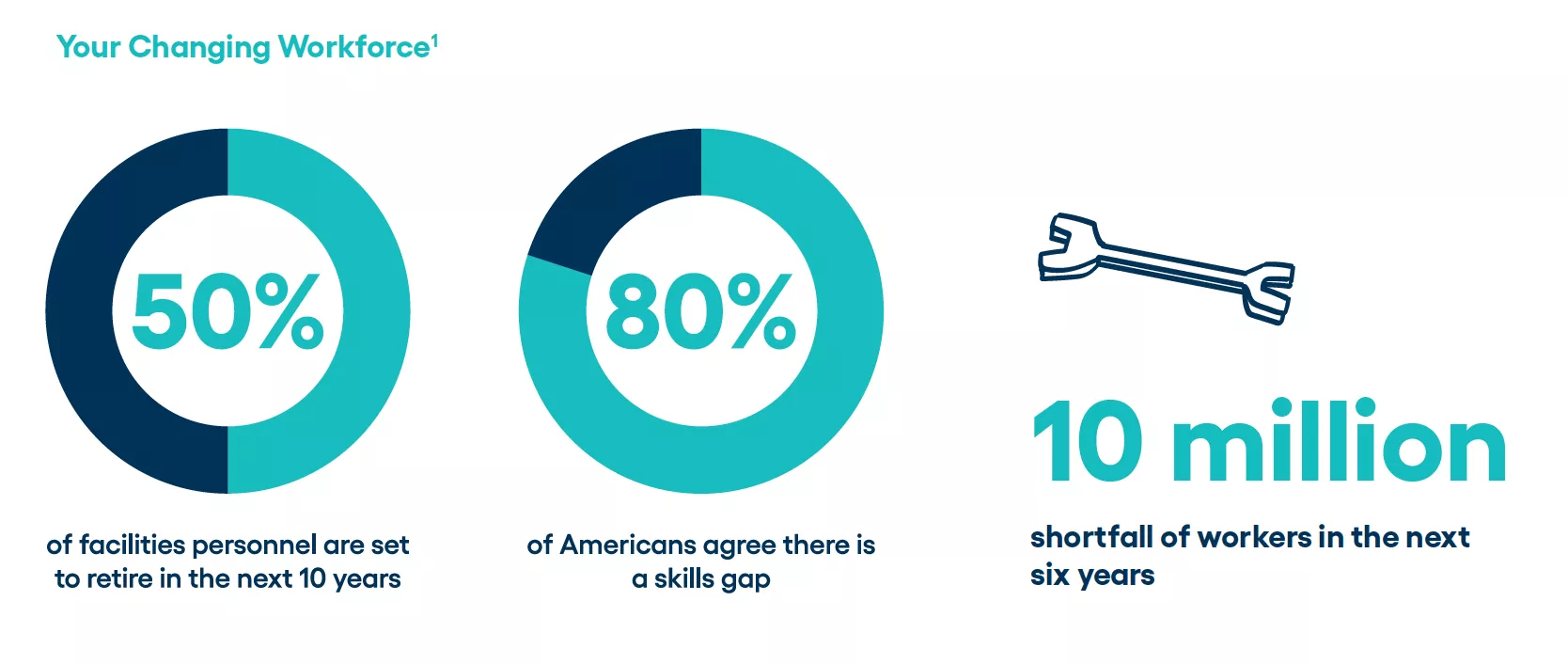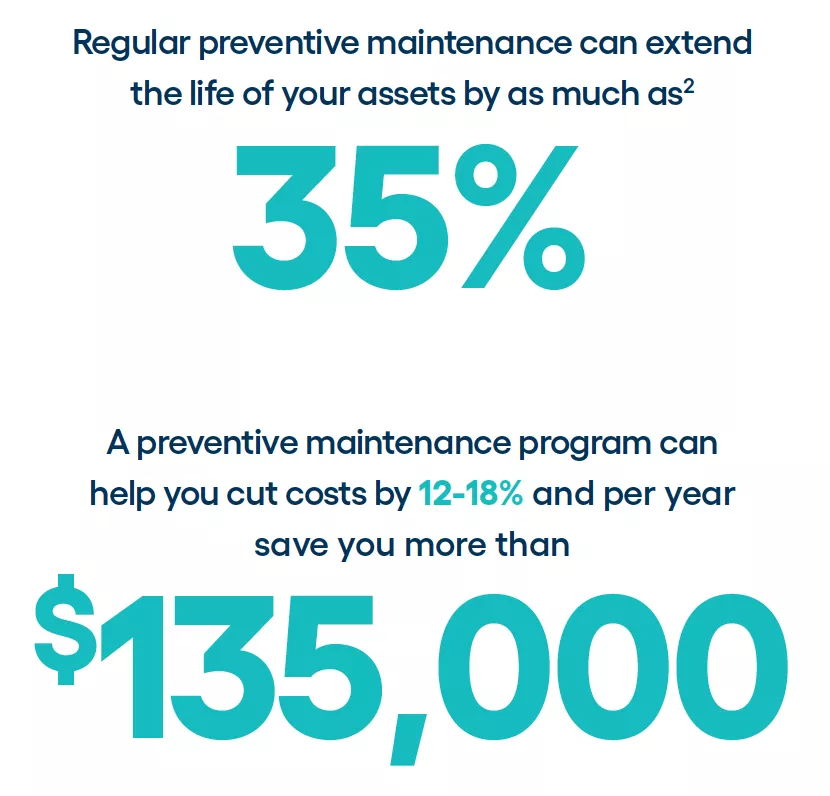Do more with less: 5 areas to maximize your resources
A strategic guide to using data to achieve operational efficiency
With changes in resourcing, staffing, budgets, and health and safety protocols, there is a lot to balance as an operations professional in today’s environment. Some of the common challenges:
Budgetary Restrictions
With a tighter budget, there’s less room for error. The average operations professional has to be smarter with the budget they have to make it go further — all while balancing the level of service and safety you need to prioritize for those you serve.
Lack of Resources
From fewer staff to tighter budgets for equipment and assets and even overall infrastructure, operating with a lack of resources means that your time, workflow and efficiency are critical.
Change in Personnel
Whether you’re dealing with a reduced workforce, remote staff members or other changes, you are being expected to be more flexible than ever with your team. And communication can make the difference between a well organized staff and one that is wasting energy and work hours.
Aging Infrastructure
All infrastructure is aging, and the sad news is that most western economies are rated at somewhere between a C+ and a D- on an A to F scale when it comes to infrastructure. A lack of funding for this infrastructure so in need of fixing pushes repairs beyond their due date. Aging infrastructure breaks down more frequently, resulting in repair that costs more and requires more time to fix. Infrastructure that’s out of order means lower service levels and less desirable and safe communities.

All of these factors combine to mean that those working in maintenance and operations find themselves struggling to help their organizations thrive. Not to mention, they often drive maintenance and operations departments from proactive maintenance into reactive maintenance mode. This adds stress, extra costs and even risk to departments and organizations on the whole. The unintended consequence is a lack of capital planning that leaves organizations blindsided by major repairs with no available funding to cover the cost.
How technology fits in
We’re all embracing technology at breakneck speed (especially those you serve on a daily basis), which elevates the expectations on your department and organization.
There are a lot of options available for organizations to integrate technology into their operations to improve efficiency without having to invest a lot of time or complicate processes.
Implementing a few simple tools can help your operations teams work efficiently with prioritization of work, allow leadership and key stakeholders to have clarity into the work being performed, assist department leaders with budget and FTE planning, gain insight into employee performance, and manage capital planning and equipment life expectancy.
Harnessing the right technology can help you stretch your resources while justifying your budget needs and ultimately creating a better environment for your staff and those you serve.
Read on to learn about a few of the technologies operations leaders are using to dramatically improve their service delivery and productivity.
1. Daily operations management
Whether you oversee an operations team of two or 20, there is likely much to be done—if not too much—and not nearly enough time, money, or resources to accomplish it all. Or so it seems, especially if your maintenance departments are dependent on paper or the memories of a few key individuals.
Universal truth: the workforce is in flux
For most operations teams, a shift in the workforce is an inescapable reality. Whether it’s longtime employees retiring without backup, the challenge of recruiting the next generation of professionals, or simply too many tasks and not enough staff (and an inability to replace or hire more staff), organizations are faced with a tale as old as time: do more with less.
The demanding market for skilled laborers is not isolated to one industry. For context, a report from Deloitte revealed that the manufacturing industry has as many as 800,000 open jobs in the U.S.—an all-time high.1 Comparably, the construction industry will need to fill around 546,000 openings this year to meet demand, according to Construction Dive.2 A widespread shortage of workers means could-be operations professionals have options and are likely to opt-in to other trades-based roles where the benefits or compensation might be more enticing or the chance to use the latest technology tools is available.
Something is missing from the toolbox
Amidst the hiring challenges trickling down to operations leaders, the show must go on! Cleaning and maintenance schedules must be maintained. Machines and assets must be inspected. Inventory must be managed. But how is it all getting divided up, tracked, or communicated about? How do team leaders request more budget/help/clarity on the prioritization of projects? Are we sure we’re using our (most likely) limited resources most effectively?
Now if only there was something that could take all this data and centralize, well, everything…
It’s time to grab onto your data and use it on the daily
No matter the size of your team doing maintenance work, a computerized maintenance management system (CMMS) can centralize all the data swimming around your operational tasks and initiatives to help your teams and employees work more efficiently. A system can also help track data and readily provide information to workers on the go, such as via a mobile device in the field.
Having a system to track all the work you do enables you to have a better understanding of:
- → Daily, weekly and monthly workload
- → Preventive vs. reactive workload
- → Backlog of work
- → Asset and equipment history
- → Labor hours and costs
- → Contractor hours and costs
The available data is then useful for reports and historical insights to illustrate all the work your department does—and helps justify budget requests. This information also helps reduce the struggle of trying to manage a variety of equipment and assets spread across the entire community, and for teams navigating transitioning workers, can help capture legacy information and establish better-informed foundations for new employees.
Ultimately, a CMMS helps you stretch your resources and reach new levels of efficiency in your work.
- 28.3% increase in maintenance productivity
- 20.1% reduction in equipment downtime
- 19.4% savings in material costs
The most important thing we have gotten out of our CMMS was the ability to search our historical data. By looking at our work history, we can identify the areas of greatest need, which let us know if upgrades are called for.
Teresa Malmberg
Public Services, City of Dunnellon, FL
2. Preventive & predictive maintenance
Many maintenance and operations teams get caught in the loop of waiting for assets to break, and only then repairing them. You know that you don’t want to operate in a reactive mode—it’s stressful, costly and anything but ideal.
Break free of break/fix
You shouldn’t be sitting around waiting for daily “fires” that are impossible to plan for yet require immediate attention. Shifting to preventive and predictive maintenance practices can help your teams get ahead of potential issues and failures to save your organization valuable time and money down the line.
The power of preventive maintenance
Preventive maintenance (PM) typically involves regularly scheduled maintenance activities designed to catch small issues before they turn into major problems that can lead to equipment failure, downtime, and costly repairs. These routine tasks can include oil changes, inspections, cleaning, and part replacements at predetermined intervals.
Leverage data for even more-informed maintenance
Predictive maintenance (PdM) uses historical data and machine learning algorithms to predict when equipment or systems are likely to fail. By scheduling maintenance before problems arise, organizations can avoid costly downtime and improve the reliability of their operations. Predictive maintenance also has the potential to improve safety by identifying hazards before they cause accidents.
In one survey of 500 plants that have implemented predictive maintenance, findings revealed the actual costs normally associated with the maintenance operation were reduced by more than 50%. The same survey found that unexpected machine failures were reduced by an average of 55%.
A dynamic maintenance duo to boost your operations
With a solid preventive maintenance program powered by the right tech, you can catch problems before they become issues. Your team can have scheduled tasks that prevent those daily fires, and it’s all organized in a calendar-based system that automatically lets you know what you need to do, and when.
Taking it one step further, lean on your data to inform predictive maintenance by not only keeping your work proactive but also anticipating when something will fail or break. With advanced workflows and automated reporting, you can use data to know when to fix an asset vs. relying on the calendar to tell you.
Wherever you are on your PM or PdM journey, technology and the organization it brings can help you truly do your best with less, using the tools to operate more proactively and confidently than ever before.

As a result [of preventive maintenance], our equipment has far exceeded the industry standard life expectancy and we receive less work order requests because our equipment is well-maintained.
Curtis Orndorff
Manager of Building Maintenance, Frederick County Public Schools
3. Inventory Management
f you can’t find it, how will you use it? For many organizations, inventory management is a prime area to tighten up to better understand your fast-moving, slow-moving and inactive inventory levels.
Is your current inventory system losing you money?
Managing inventory is also more than simply making sure you know where the extra lightbulbs are kept. In a time where resources are extra-tight, finding a more effective way can play an important role in effectively managing your operations to reduce expenses(!) and increase productivity.
It’s time to use your (inventory) data
An inventory management system can help ensure the right product is in the right place at the right time with minimal expense and effort.
Gain visibility into data and access to historic trends helps ensure that inventory levels are optimized through things like:
- → Optimizing how you store, locate, and find items
- → Documenting an accurate count and specific details for each inventory item in your CMMS
- → Setting up minimum/maximum or high/low levels for inventory items and automating alerts in your CMMS
- → Using mobile barcoding to make inputting inventory easier
The result is better control and improved allocation for the true cost of ownership.
Our constituents want to understand the total cost of ownership of our buildings … This is how much we’re spending on preventive maintenance, on reactive maintenance, in inventory, [etc.]. School districts need to be able to tell that story so that you can justify the resources that you need.
Monique Roumo
Executive Director of Operations, Baltimore City Public Schools
4. Energy Management
With the rising costs of just about everything, energy is one of the biggest line items for most organizations, and it often results in unnecessary spending. So, what if you could identify utility waste, better prioritize action, and make smarter operational decisions with centralized management of utilities?
It’s time to rethink your energy strategy
Tired of paying for utility waste or unnecessary consumption? A robust energy management strategy can help decrease utility costs, extend the life cycle of assets, and help reduce your carbon footprint. Is your organization dedicated to sustainability? Understanding your energy usage can help reduce greenhouse gas emissions and mitigate the risk against the effects of climate change.
Imagine, a single dashboard for trends, costs, and usage
Your energy usage data is already there. You just need a platform to help make sense of it all so you can make more informed decisions. An energy management solution can allow operations professionals to track data that empowers them to make smarter, more sustainable decisions surrounding energy usage.
Smarter energy management today for tomorrow’s time and cost savings
Utilities and energy are often-overlooked areas of operations that can be run more efficiently and create savings to go back into the organization. An energy management solution facilitates better planning for capital investments, helps organizations see where they can save on utilities, and even helps them meet regulatory requirements.
There’s a tremendous amount of data available with utility bills, but in reality, what’s the best use of our time to draw out? [An energy management solution enables us to] dedicate our time to the analytics for the things we care about.
Mark Clinch
Director of Facilities & Energy Management, Town of Normal, IL

5. Capital Planning
Thinking about creating a 5, 10 or 20-year capital expenditure forecast? It can feel daunting! For operations leaders, there is little room to make a major mistake with large expenditures, so having the data—and being able to make correct choices—is crucial.
Use data to peek around the corner
It can be difficult, if not impossible, to squeeze a large, unplanned expense into the budget when it comes up by surprise. For organizations and communities with aging infrastructure, it’s especially important to be looking ahead to what capital expenses are on the horizon and planning for them now—and your data is the secret to unlocking a brighter future.
Your long-term planning just got easier
New technologies have made it easier than ever to create a plan that is accurate and properly prioritized. Strategic asset management is an approach to asset management and long-term planning that can be used to better understand and visualize your asset management needs today, as well as 5–20+ years into the future.
The right tools can help:
- Predict asset life
- Justify funding requests
- Compare various funding scenarios
Turn today’s data into service- and budget-optimized strategies
With a strategic asset management system, you can use lifecycle modeling to try out “what if” scenarios, balancing budget, assets and expected levels of service, to make better data-driven decisions, especially around capital planning.
We all face diminishing budgets, less manpower and deteriorating buildings. [Operations management software] can make operations more efficient and help justify keeping resources and job positions to management and your CFO.
Barry Hipp
Senior Director of District Operations, Cleburne Independent School District
Better understand five areas where you can maximize your maintenance and operations resources in this guide. You'll learn more about efficient tools for:
- Daily operations management
- Preventive and predictive maintenance
- Inventory management
- Energy management
- Capital project management




